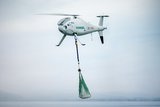ViaSat Enerdyne demonstrates EnerLinks III Ground Modem Transceiver Receiving Legacy FM Analog Video from Multiple Unmanned Aerial Systems
Last week at the Unmanned System Demonstration at Webster Field near Patuxent River Maryland, the Enerdyne division of ViaSat successfully received and displayed analog-transmitted NTSC video from a variety of Unmanned Aerial Systems (UAS) using its digital EnerLinksIII Ground Modem Transceiver (GMT).
Based on a programmable radio architecture, the EnerLinksIII GMT is designed to operate with digital waveforms transmitted by aircraft using EnerLinks equipment, but by adding the Analog Mode option, the GMT can also receive analog FM video transmissions.
During the Webster Field demonstration, the EnerLinks GMT captured video transmitted from unmanned aircraft such as the Insitu Scan Eagle, AAI Aerosonde MK 4.7, L-3 Mobius, Aerovironment Puma, and MUDO AeroStar, receiving transmissions in L-, S-, and C-bands.
The ability to receive video from older, analog systems enables UAS suppliers to begin to upgrade to improved digital technology while still interoperating with the rest of their fleet.
“Our customer base has a significant number of systems flying with analog links. As they transition to EnerLinks digital technology, they’ll be operating a mix of both legacy and new technology. The addition of analog modes allows them to use one ground receiver for all deployed units,” said ViaSat Enerdyne division general manager Steve Gardner.
The GMT includes the ability to digitize and compress received analog video signals using H.264 compression and embeds the compressed video into an MPEG-2 transport stream for distribution over an IP network to standard exploitation systems, including the EnerViewTM viewer.
Customers who already have EnerLinksIII GMT products can upgrade them to add the EnerLinks Analog Mode, which is a simple software download to their systems. Analog Mode in the GMT dovetails with the EnerLinks Digital Video Over Analog (DVA) product, which allows legacy analog FM transmitters to send an AES-256 encrypted signal that contains an H.264 digital full motion video stream accompanied by up to 2 Mbps of IP traffic.
With both the analog capable GMT and the DVA, UAV fleets can maintain interoperability with a mix of upgraded and unmodified aircraft and ground stations.
Related Equipment in Defence Insight
More from Uncrewed Vehicles
-
Jammer resistant drone designs spark search for countermeasures
The Russia-Ukraine conflict has driven another stage of evolution for drones and the counter measures to defend against them.
-
![L3Harris launches Amorphous software for control of uncrewed platforms]()
L3Harris launches Amorphous software for control of uncrewed platforms
The new Amorphous software is a universal controller that would allow a single operator to control a swarm of “thousands” of uncrewed systems, from drones to underwater platforms.
-
ideaForge unveils new UAVs at Aero India 2025
India UAV supplier ideaForge has launched the Netra 5 and Switch V2 drones at Aero India 2025, boasting of enhanced endurance, AI-driven autonomy and improved operational capabilities.
-
![Shaping the future of defence: What 2025 holds for the global drone market]()
Shaping the future of defence: What 2025 holds for the global drone market
The UAV market is experiencing unprecedented growth, with innovations in technology and battlefield applications driving demand across military sectors. From the battlefields of Ukraine to NATO exercises and beyond, drones are transforming how wars are fought and supported.
-
![Maris-Tech confirms customers signing up for Jupiter Drones codec and AI-powered system]()
Maris-Tech confirms customers signing up for Jupiter Drones codec and AI-powered system
Launched at AUSA in October, the company’s multi-stream video codec is attempting to bring a new lease of life to drone technology through its AI accelerator.
-
![AUSA 2024: Quantum-Systems targets big 2025 with UAS developments]()
AUSA 2024: Quantum-Systems targets big 2025 with UAS developments
Quantum-Systems has been upgrading its UAS family, with new versions of the Vector, Reliant and Twister drones set for release throughout 2025.
























